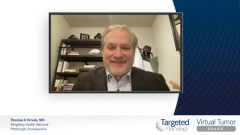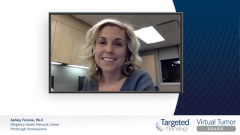
Case 3: Newly Diagnosed High-Grade Serous Carcinoma
Experts in gynecologic oncology review the case of a 69-year-old woman with newly diagnosed high-serous carcinoma and discuss their approach to maintenance therapy after first-line chemotherapy plus bevacizumab.
Episodes in this series

Thomas C. Krivak, MD: For the third and final case, this is a newly diagnosed high-grade serous ovarian cancer patient. This is a 69-year young woman who presents to the emergency room with shortness of breath. On physical exam, she has large volume ascites. CT scans show bilateral pulmonary pleural effusions and no PE [pulmonary embolism]. CT scan of the abdomen and pelvis shows peritoneal carcinomatosis and bilateral adnexal masses. CA [cancer antigen] 125 is 525. Thoracentesis drains 1500 cc’s of fluid, high-grade adenocarcinoma as well as the paracentesis gets 4.5 liters showing high-grade adenocarcinoma. Core biopsy of the omentum shows high-grade serous carcinoma as well.
The patient undergoes debulking surgery and has an incomplete cytoreduction, a suboptimal debulking with gross residual. The molecular testing has p53-positive, PAX8, BRCA1/2 wild type and the patient is noted to be homologous recombination deficient with respect to her tumor.
What are the options for this patient? After completion of frontline therapy, what would be your approach to chemotherapy as well as chemotherapy with bevacizumab [Avastin]? How are you going to influence some of these decisions? Again, this is a patient that many of us would say why would we do a debulking? This would be somebody that I may consider neoadjuvant chemotherapy. Again, maybe she was symptomatic at the time. I know that at times, I see patients who are very symptomatic, and I scratch my head and I’m thinking maybe I should try it, maybe I shouldn’t, and then end up realizing I’m in a surgery that unfortunately is not going to get the best therapeutic benefit because she’ll have macroscopic disease and do our best with that. But she recovers from surgery.
A lot of us would say this would have been an ideal patient to consider neoadjuvant chemotherapy with interval debulking. That would be 1 strategy. As we were reading through this, we’d say, “Hey, this could be somebody we could do neoadjuvant chemotherapy.” Obviously, the goal is optimal cytoreductive surgery to microscopic and some of us would say that with neoadjuvant chemotherapy followed by interval debulking would be the way to go. Cecelia, if you do neoadjuvant, let’s throw it in there. I’m not going to do debulking, I’m going to do neoadjuvant because she’s got the core biopsy, she’s got the pleural effusion, she’s got ascites. Tom Krivak did the debulking because when he gets confused, he operates, and he should think more and that’s fine.
Cecelia H. Boardman, MD: No. I mean, I am card carrying Karl Podratz’s fellow. I’m Mayo Clinic trained. We go to the OR [operating room]. And it is uncommon for me to do neoadjuvant but I did scratch my head and say, “Hmm, this lady might be a better candidate for neoadjuvant.” But I agree with you, Tom, that sometimes they are so symptomatic, their nutrition is compromised, they can’t eat, you’ve got repeated paracentesis, and sometimes you just say I’ve got to go to the OR. But this is the optimal patient for bevacizumab. Bevacizumab is going to help you a lot with your ascites and your pleural effusions.
In this patient the decision to go to the OR would be 1 that I would have made and then get her first cycle of chemotherapy on board quickly postoperative in the first 1 to 2 weeks, so that we can start to get some benefit from that, obviously knowing that you can’t initiate bevacizumab until cycle 2 until it’s been at least 30 days since surgical incision. But I love bevacizumab for this patient. And then, because she is HRD [homologous recombination deficient], she’s going to be a good candidate for PAOLA maintenance. I talk to her about that from the very get-go, that chemotherapy cycle 1, cycle 2 is chemotherapy plus bevacizumab, and then we get through cycle 6. And even if she’s only a PR [partial response], which is highly likely given how she has presented, that maintenance therapy, as Dr Chan astutely alluded to, that it’s not just maintenance, it’s therapy, it’s active treatment. We know Avastin as a single agent is active in recurrent ovarian cancer. PARP inhibitors as single agents are active in recurrent ovarian cancer. These are maintenance but they’re treatments. In the studies you certainly could see some continued response after stopping chemotherapy and continuing them on bevacizumab with the addition of PARP. That’s where I would go with her.
Thomas C. Krivak, MD: John, what do you think?
John K. Chan, MD: I don’t have much to add. In a patient with massive ascites, pleural effusion, the Avastin will significantly improve the quality of life for these patients. And since you started Avastin, these patients should be continued on olaparib [Lynparza], which is the combination that can get us 37 months of progression-free survival [PFS] benefit. That’s how I would treat this patient, given her disease presentation and her biomarker.
Thomas C. Krivak, MD: I agree. I would ask this question. It’s interesting that she’s HRD positive. We know this is HRD positive, but knowing the data for HRP [homologous recombination proficiency], what if she had a homologous recombination proficient tumor and she was on bevacizumab, would you say I’m just going to leave her on single-agent bevacizumab? Would you say, you know what, I want to try niraparib [Zejula] upfront because of the PRIMA data, or would you say; Cecelia, you had a nice comment about these medications are similar but not the same, would you consider the OVARIO protocol, the OVARIO type of regimen which is Avastin with niraparib if the patient’s tumor is HRP and she was on bevacizumab? Leave her on bevacizumab? Switch to single-agent Avastin or continuous single-agent Avastin, switch to single-agent niraparib? Would anybody add niraparib and say I’m going to do a PAOLA-like regimen with a different PARP in the HRP population to see what happens?
Cecelia H. Boardman, MD: It’s interesting. We go back to the GOG-0218 data, and when you looked at that trial, patients who received chemotherapy plus bevacizumab followed by no [bevacizumab] in maintenance had no benefit from the bevacizumab. And if I’m committed to bevacizumab, I’m committed to bevacizumab in maintenance. That to me is important, although obviously NCCN [National Comprehensive Cancer Network] guidelines allow for us to change therapies. And for therapies, again those who transportation, or develop significant proteinuria, if there are some clinical indicators, we certainly can change drug. I’ve never done OVARIO outside of clinical trial, and the only subtlety would be could I get it approved by insurance because it’s not in the NCCN guidelines. So there’s certainly response data, and in a clinical trial setting you could do it, but I haven’t done it in the community setting because I worry about getting insurance auth [authorization] based on available NCCN guidelines. I think again, we have lots of choices and then you individualize it to what makes the most sense for the patient.
Thomas C. Krivak, MD: John, any thoughts on that?
John K. Chan, MD: Yes, the only thing I would add to what Cecelia was saying is are we remiss by not giving this patient a PARP? Because this may be the only time, she’ll be able to get a PARP if she’s HR proficient, right? If you think about the PRIMA trial, the patients who didn’t get PARP, the median PFS was only 5 months.
Thomas C. Krivak, MD: Yes.
John K. Chan, MD: That means more than half of the patients will be platinum resistant if you don’t give them a PARP. If you don’t give them bevacizumab or you don’t give them a PARP, right? More than half of these patients, if you don’t give them some sort of a maintenance, they will be resistant. And when they become resistant and you don’t have a marker for them because they’re HR proficient, they will never see PARP again unless you use it off trial, off-label, or on a protocol or something like that.
Cecelia H. Boardman, MD: But, if we continue their bevacizumab maintenance, the likelihood is their recurrence is going to be platinum sensitive. And then if they respond to platinum combination in second line, you’re biomarker agnostic and you can put them on PARP with a platinum-sensitive recurrence. That’s a subtlety that sometimes I will use in that patient where they’re HRP and they need the clinical benefit of the bevacizumab. I might just let the bevacizumab roll in maintenance and then hope they’re platinum-sensitive recurrence and then do a platinum doublet in second line with PARP maintenance to follow that because it’s biomarker agnostic.
Thomas C. Krivak, MD: The HRD, we have really good options, we know what to do or have good options to select from. HRP shows you the struggle and how we’re worried about what’s going to happen when they recur or as John is saying, HRD, they’re going to have 37 months because we know that we have time to take a breath and enjoy some of the long, the strong hazard ratios we saw in the long, and increased PFS. There are some slides here that show how PAOLA was an excellent study, in my opinion, real clinical applicability. Patients received bevacizumab and it was 2:1 randomizations of olaparib versus placebo. And, again, patients were treated for about 2 years with olaparib versus 2 years with placebo and then were treated with bevacizumab, with upfront chemotherapy and then overlapping olaparib with bevacizumab. We had talked about some of these results, and we had seen the results earlier on.
Again, SOLO1 for BRCA-mutated patients, we had seen this slide earlier, these patients had a tremendous response, hazard ratio of 0.3, significant deltas with respect to the progression-free survival. In patients who are HRD positive, patients with BRCA mutations, we know that these PARP medications, olaparib, niraparib, are going to do tremendous benefit with respect to progression-free survivals. We’ve seen PFS1s, we’ve seen some PFS2s. We’re all hopeful that we’re going to start to see some OS [overall survival] with some of these trials. Lots of options for these patients.
Transcript Edited for Clarity













































